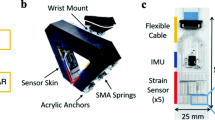Abstract
Haptic feedback is a key component in human-computer interaction, providing human users with immersive and realistic experiences. Thermal feedback, a form of haptic feedback, enables users to recognize the materials of virtual objects by simulating changes in skin temperature during hand-object interactions. In order to carry out these simulations, it is essential to characterize skin temperature changes as the basis for the simulations. One of the characterizing methods is utilizing the data on the change in skin temperature directly measured. Creating a dataset of the changes in skin temperature during hand-object interactions with human fingers presents challenges due to inconsistent measurement settings and laborious processes. An artificial finger with thermal properties similar to those of human fingers could overcome the problems. In the present study, we analyzed the tolerance range of the thermal effusivity for the artificial finger, aiming to replicate thermal transients akin to those in human fingers during hand-object interactions. This range was investigated using a thermal model that predicts skin temperature change based on the thermal properties of skin and materials. As a result, the thermal effusivity of the artificial finger is required to be in the range of 1090 to 1281 \((J/m^2\)s\(^{1/2}K)\) for the measurement to be valid when the contact material spans a wide thermal property range. Based on these findings, we discuss candidate materials for the artificial finger and the potential applications in a machine-learning model for thermal displays, as well as an automatic material classification system based on thermal cues for robot hands.
Access this chapter
Tax calculation will be finalised at checkout
Purchases are for personal use only
Similar content being viewed by others
References
Ho, H.-N.: Material recognition based on thermal cues: mechanisms and applications. Temperature 5(1), 36–55 (2018). https://doi.org/10.1080/23328940.2017.1372042
Jones, L.A., Ho, H.-N.: Warm or cool, large or small? The challenge of thermal displays. IEEE Trans. Haptics 1(1), 53–70 (2008). https://doi.org/10.1109/TOH.2008.2
Ino, S. et al.: A tactile display for presenting quality of materials by changing the temperature of skin surface. In: Proceedings of 1993 2nd IEEE International Workshop on Robot and Human Communication, Tokyo, Japan, pp. 220–224 (1993). https://doi.org/10.1109/ROMAN.1993.367718
Balasubramanian, J.K., Kodak, B.L., Vardar, Y.: SENS3: multisensory database of finger-surface interactions and corresponding sensations. arXiv (2024). https://doi.org/10.48550/arXiv.2401.01818
Ho, H.-N., Jones, L.A.: Modeling the thermal responses of the skin surface during hand-object interactions. J. Biomech. Eng. 130(2), 021005 (2008). https://doi.org/10.1115/1.2899574
Havenith, G., van de Linde, E.J.G., Heus, R.: Pain, thermal sensation and cooling rates of hands while touching cold materials. Eur. J. Appl. Physiol. 65(1), 43–51 (1992). https://doi.org/10.1007/BF01466273
Ho, H.-N., Jones, L. A.: Material identification using real and simulated thermal cues. In: The 26th Annual International Conference of the IEEE Engineering in Medicine and Biology Society, pp. 2462–2465. San Francisco (2004). https://doi.org/10.1109/IEMBS.2004.1403711
Ho, H.-N., Jones, L.A.: Contribution of thermal cues to material discrimination and localization. Percept. Psychophys. 68(1), 118–128 (2006). https://doi.org/10.3758/BF03193662
Dellon, E.S., Keller, K., Moratz, V., Dellon, A.L.: The relationships between skin hardness, pressure perception and two-point discrimination in the fingertip. J. Hand Surg. 20(1), 44–48 (1995). https://doi.org/10.1016/S0266-7681(05)80015-4
Incropera, F.P., Dewitt, D.P., Bergman, T.L., Lavine, A.S.: Fundamentals of Heat and Mass Transfer, 6th edn. Wiley, New York (2006)
Ho, H.-N., Jones, L. A.: Thermal model for hand-object interactions. In: 2006 14th Symposium on Haptic Interfaces for Virtual Environment and Teleoperator Systems, Alexandria, VA, USA, pp. 461–467 (2006). https://doi.org/10.1109/HAPTIC.2006.1627108
Ronald, V., Stanley, B., Christine, F., Francis, M.: Effects of hydration on tactile sensation. Somatosens. Mot. Res. 15(2), 93–108 (1998). https://doi.org/10.1080/08990229870826
Stevens, J.C., Choo, K.K.: Temperature sensitivity of the body surface over the life span. Somatosens. Motor Res. 15(1), 13–28 (1998). https://doi.org/10.1080/08990229870925
MatWeb: Online Materials Information Resource Nylon 6, Unreinforced, Flame Retardant. https://x.gd/o0Y1Q. Accessed 29 Mar 2024
MatWeb: Online Materials Information Resource Wefapress PEEK mod. https://x.gd/PXbvX. Accessed 22 Jan 2024
MatWeb: Online Materials Information Resource Haysite H208 Polyester, Magnetic Permeable. https://x.gd/mKKj5. Accessed 22 Jan 2024
Shin-Etsu Chemistory Liquid silicone rubber for moldmaking. https://x.gd/VtKLi. Accessed 19 Apr 2024
Bhattacharjee, T., Wade, J., Kemp. C. C.: Material recognition from heat transfer given varying initial conditions and short-duration contact. In: Robotics: Science and Systems, Rome, Italy, (2015). https://doi.org/10.15607/RSS.2015.XI.019
Bhattacharjee, T., Clever, H.M., Wade, J., Kemp, C.C.: Material recognition via heat transfer given ambiguous initial conditions. IEEE Trans. Haptics 14(4), 885–896 (2021). https://doi.org/10.1109/TOH.2021.3089990
Osawa, Y., Kase, K., Domae, Y., Furukawa, Y., Kheddar, A.: Material classification using active temperature controllable robotic gripper. In: 2022 IEEE/SICE International Symposium on System Integration (SII), pp. 479–484. IEEE, Narvik (2022). https://doi.org/10.1109/SII52469.2022.9708761
Acknowledgments
This work was supported by JSPS KAKENHI Grant Number 22H03679.
Author information
Authors and Affiliations
Corresponding author
Editor information
Editors and Affiliations
Rights and permissions
Copyright information
© 2025 The Author(s), under exclusive license to Springer Nature Switzerland AG
About this paper
Cite this paper
Kameyama, N., Ho, HN. (2025). Analysis of Thermal Properties of Artificial Fingers for Recording Thermal Transients During Hand-Object Interactions. In: Kajimoto, H., et al. Haptics: Understanding Touch; Technology and Systems; Applications and Interaction. EuroHaptics 2024. Lecture Notes in Computer Science, vol 14769. Springer, Cham. https://doi.org/10.1007/978-3-031-70061-3_17
Download citation
DOI: https://doi.org/10.1007/978-3-031-70061-3_17
Published:
Publisher Name: Springer, Cham
Print ISBN: 978-3-031-70060-6
Online ISBN: 978-3-031-70061-3
eBook Packages: Computer ScienceComputer Science (R0)




